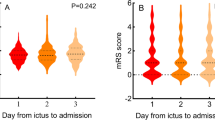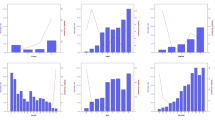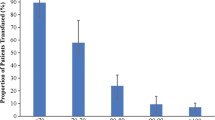Abstract
Background
There is a paucity of conclusive evidence regarding the impact of downward drift in hematocrit levels among patients who have undergone surgical clipping for aneurysmal subarachnoid hemorrhage (aSAH). This study endeavors to explore the potential association between hematocrit drift and mortality in this specific patient population.
Methods
A cohort study was conducted, encompassing adult patients diagnosed with aSAH at a university hospital. The primary endpoint was follow-up mortality. Propensity score matching was employed to align patients based on their baseline characteristics. Discrimination capacity across various models was assessed and compared using net reclassification improvement (NRI).
Results
Among the 671 patients with aSAH in the study period, 118 patients (17.6%) experienced an in-hospital hematocrit drift of more than 25%. Following adjustment with multivariate regression analysis, patients with elevated hematocrit drift demonstrated significantly increased odds of mortality (aOR: 2.12, 95% CI: 1.14 to 3.97; P = 0.019). Matching analysis yielded similar results (aOR: 2.07, 95% CI: 1.05 to 4.10; P = 0.036). The inclusion of hematocrit drift significantly improved the NRI (P < 0.0001) for mortality prediction. When in-hospital hematocrit drift was served as a continuous variable, each 10% increase in hematocrit drift corresponded to an adjusted odds ratio of 1.31 (95% CI 1.08–1.61; P = 0.008) for mortality.
Conclusions
In conclusion, the findings from this comprehensive cohort study indicate that a downward hematocrit drift exceeding 25% independently predicts mortality in surgical patients with aSAH. These findings underscore the significance of monitoring hematocrit and managing anemia in this patient population.



Similar content being viewed by others
Data availability
Original data is available from the corresponding author with reasonable request.
References
Badenes R, Oddo M, Suarez JI et al (2017) Hemoglobin concentrations and RBC transfusion thresholds in patients with acute brain injury: an international survey. Crit Care 21(1):159
Baron DM, Hochrieser H, Posch M et al (2014) Preoperative anaemia is associated with poor clinical outcome in non-cardiac surgery patients. Br J Anaesth 113(3):416–423
Bilotta F, Guerra C, Rosa G (2013) Update on anesthesia for craniotomy. Curr Opin Anaesthesiol 26(5):517–522
Boffetta P, Islami F, Vedanthan R et al (2013) A U-shaped relationship between haematocrit and mortality in a large prospective cohort study. Int J Epidemiol 42(2):601–615
Cable CA, Razavi SA, Roback JD et al (2019) RBC Transfusion Strategies in the ICU: A Concise Review. Crit Care Med 47(11):1637–1644
Carson JL, Guyatt G, Heddle NM et al (2016) Clinical practice guidelines from the AABB: red blood cell transfusion thresholds and storage. JAMA 316(19):2025–2035
Ceulemans A, Pinckaers FME, Postma AA et al (2024) Association between anemia and clinical outcome in acute ischemic stroke patients treated with endovascular treatment. J Stroke 26(1):87–94
Chen P, Wang Y, Zhang XH et al (2021) The use of acute normovolemic hemodilution in clipping surgery for aneurysmal subarachnoid hemorrhage. World Neurosurg 148:e209–e217
Chittiboina P, Conrad S, McCarthy P et al (2011) The evolving role of hemodilution in treatment of cerebral vasospasm: a historical perspective. World Neurosurgery 75(5–6):660–664
Chittiboina P, Guthikonda B, Wollblad C et al (2011) A computational simulation of the effect of hemodilution on oxygen transport in middle cerebral artery vasospasm. J Cereb Blood Flow Metab 31(11):2209–2217
Da Silva IRF, Gomes JA, Wachsman A et al (2017) Hematologic counts as predictors of delayed cerebral ischemia after aneurysmal subarachnoid hemorrhage. J Crit Care 37:126–129
Dankbaar JW, Slooter AJC, Rinkel GJE et al (2010) Effect of different components of triple-H therapy on cerebral perfusion in patients with aneurysmal subarachnoid haemorrhage: a systematic review. Critical Care 14(1):R23
Darkwah Oppong M, Lohrer L, Wrede KH et al (2023) Reevaluation of risk factors for aneurysmal subarachnoid hemorrhage associated epilepsy. J Neurol Sci 444:120519
Deem S, Diringer M, Livesay S et al (2023) Hemodynamic management in the prevention and treatment of delayed cerebral ischemia after aneurysmal subarachnoid hemorrhage. Neurocrit Care 39(1):81–90
Desjardins P, Turgeon AF, Tremblay MH et al (2012) Hemoglobin levels and transfusions in neurocritically ill patients: a systematic review of comparative studies. Crit Care 16(2):R54
Dhar R, Zazulia AR, Derdeyn CP et al (2017) RBC transfusion improves cerebral oxygen delivery in subarachnoid hemorrhage. Crit Care Med 45(4):653–659
Ekelund A, Reinstrup P, Ryding E et al (2002) Effects of iso- and hypervolemic hemodilution on regional cerebral blood flow and oxygen delivery for patients with vasospasm after aneurysmal subarachnoid hemorrhage. Acta Neurochir (Wien) 144(7):703–12 (discussion 12–3)
Haegens NM, Gathier CS, Horn J et al (2018) Induced hypertension in preventing cerebral infarction in delayed cerebral ischemia after subarachnoid hemorrhage. Stroke 49(11):2630–2636
Helenius K, Longford N, Lehtonen L et al (2019) Association of early postnatal transfer and birth outside a tertiary hospital with mortality and severe brain injury in extremely preterm infants: observational cohort study with propensity score matching. BMJ (Clinical research ed) 367:l5678
Kramer AH, Diringer MN, Suarez JI et al (2011) Red blood cell transfusion in patients with subarachnoid hemorrhage: a multidisciplinary North American survey. Crit Care 15(1):R30
Kurtz P, Helbok R, Claassen J et al (2016) The effect of packed red blood cell transfusion on cerebral oxygenation and metabolism after subarachnoid hemorrhage. Neurocrit Care 24(1):118–121
Lee YR, Pustejovsky JE (2023) Comparing random effects models, ordinary least squares, or fixed effects with cluster robust standard errors for cross-classified data. Psychol Methods. https://doi.org/10.1037/met0000538
Lin F, Lu C, Li R et al (2024) The association between hemoglobin concentration and clinical outcomes after aneurysmal subarachnoid hemorrhage: Insights from the LongTEAM registry. CNS Neurosci Ther 30(4):e14506
Liu Y, Li L, Hu H et al (2023) Association between preoperative hematocrit and postoperative 30-day mortality in adult patients with tumor craniotomy. Front Neurol 14:1059401
Oddo M, Milby A, Chen I et al (2009) Hemoglobin concentration and cerebral metabolism in patients with aneurysmal subarachnoid hemorrhage. Stroke 40(4):1275–1281
Ouldali N, Toubiana J, Antona D et al (2021) Association of intravenous immunoglobulins plus methylprednisolone vs immunoglobulins alone with course of fever in multisystem inflammatory syndrome in children. JAMA 325(9):855–864
Raposeiras Roubin S, Abu Assi E, Cespon Fernandez M et al (2020) Prevalence and prognostic significance of malnutrition in patients with acute coronary syndrome. J Am Coll Cardiol 76(7):828–840
Said M, Gümüs M, Rodemerk J et al (2022) Systematic review and meta-analysis of outcome-relevant anemia in patients with subarachnoid hemorrhage. Sci Rep 12(1):20738
Sampson TR, Dhar R, Diringer MN (2010) Factors associated with the development of anemia after subarachnoid hemorrhage. Neurocrit Care 12(1):4–9
Sen J, Belli A, Albon H et al (2003) Triple-H therapy in the management of aneurysmal subarachnoid haemorrhage. The Lancet Neurology 2(10):614–621
Shah AH, Snow R, Wendell LC et al (2023) Association of hemoglobin trend and outcomes in aneurysmal subarachnoid hemorrhage: A single center cohort study. J Clin Neurosci 107:77–83
Tibi P, McClure RS, Huang J et al (2021) STS/SCA/AmSECT/SABM update to the clinical practice guidelines on patient blood management. Ann Thorac Surg 112(3):981–1004
TomićMahečić T, Brooks R, Noitz M et al (2022) The limits of acute anemia. J Clin Med 11(18):5279
Treggiari MM, Deem S (2009) Which H is the most important in triple-H therapy for cerebral vasospasm? Curr Opin Crit Care 15(2):83–86
Tykocki T, Kostyra K, Bojanowski K et al (2014) Analysis of the serum components in acute period after subarachnoid hemorrhage. Turk Neurosurg 24(5):672–678
Zeineddine HA, Honarpisheh P, McBride D et al (2022) Targeting hemoglobin to reduce delayed cerebral ischemia after subarachnoid hemorrhage. Transl Stroke Res 13(5):725–735
Funding
The research was funded by the National Natural Science Foundation of China (Grant No. 82371318).
Author information
Authors and Affiliations
Contributions
XW and LM conceived the study and designed the protocol.
XW and JG acquired the data.
XW and WC analyzed the data.
XW and XQ wrote the first draft of the paper.
XW, XQ, JG, WC, CY, and LM critically revised successive drafts of the paper and approved the final version.
Corresponding author
Ethics declarations
Ethics approval
The institutional review board of the ethics committee of West China Hospital approved the study (2023072).
Consent to participate
The institutional review board of the ethics committee of West China Hospital granted a waiver of informed consent due to the minimal risk posed to patients.
Consent for publication
Not applicable.
Competing interests
The authors declare that they have no conflict of interest.
Additional information
Publisher's Note
Springer Nature remains neutral with regard to jurisdictional claims in published maps and institutional affiliations.
Supplementary Information
Below is the link to the electronic supplementary material.
Rights and permissions
Springer Nature or its licensor (e.g. a society or other partner) holds exclusive rights to this article under a publishing agreement with the author(s) or other rightsholder(s); author self-archiving of the accepted manuscript version of this article is solely governed by the terms of such publishing agreement and applicable law.
About this article
Cite this article
Wang, X., Chen, W., Qiu, X. et al. Hematocrit drift and outcomes in surgical patients with aneurysmal subarachnoid hemorrhage. Acta Neurochir 166, 202 (2024). https://doi.org/10.1007/s00701-024-06097-9
Received:
Accepted:
Published:
DOI: https://doi.org/10.1007/s00701-024-06097-9




